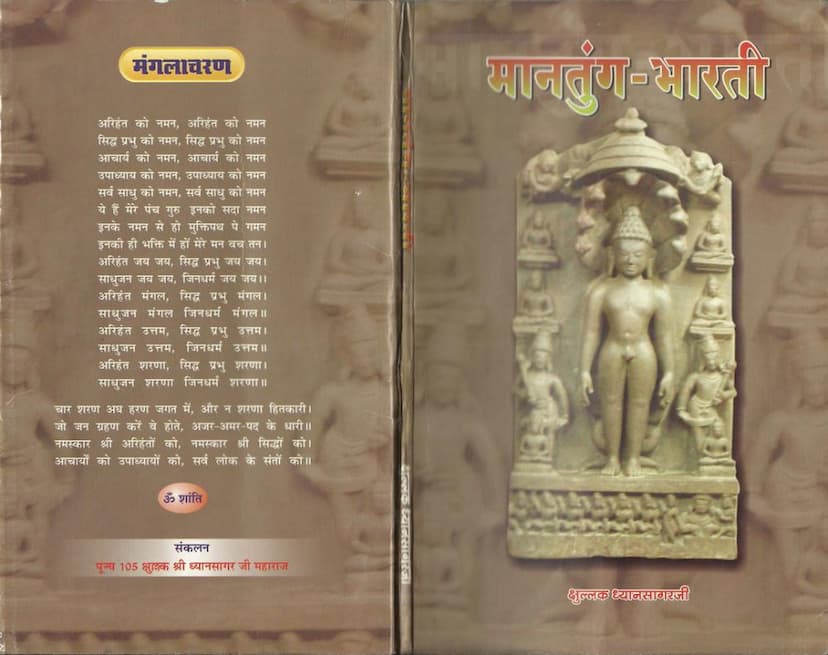Mantung Bharti
Added to library: September 2, 2025

Summary
Here's a comprehensive summary of the Jain text "Mantung Bharti," based on the provided pages:
Overall Nature of the Book:
"Mantung Bharti" is a compilation dedicated to the revered Jain Acharya Mantung (also known as Mantungacharya) and his spiritual contributions. It primarily features the Bhaktamar Stotra, a highly popular and powerful devotional hymn composed in Sanskrit by Acharya Mantung. The book includes a Hindi poetic translation, word-meaning explanation (anvayartha), and an inner essence interpretation (antardhvani) of the Bhaktamar Stotra, all prepared by the esteemed Pujya Kshullak Shri Dhyansagar Ji Maharaj, a disciple of the highly respected Acharya Shri Vidyasagar Ji Maharaj. Additionally, the book includes another less-known work by Acharya Mantung, the Namiun Stotra (also known as Bhayhar Santhavo), which is a praise of Lord Parshvanath in Prakrit, also presented with a Hindi poetic translation and explanation.
Key Components and Themes:
-
Mangalacharan (Invocation): The book begins with a traditional Jain invocation, paying homage to the Panch Parameshtis (Arhants, Siddhas, Acharyas, Upadhyayas, and Sadhu/Saints). This section emphasizes the protective and liberating power of these revered beings and the Jain Dharma.
-
Bhaktamar Stotra: This is the central piece of the book.
- Author: Attributed to Acharya Mantung.
- Significance: Considered one of the most powerful and popular devotional hymns in Jainism, second only to the Namokar Mahamantra. It is believed to possess significant mantra-shakti (power of mantras).
- Content: The Bhaktamar Stotra consists of 48 verses, each detailing the glories and attributes of the first Tirthankar, Lord Adinath. The verses are rich in philosophical insights, praising the Tirthankar's omniscience, detachment, compassion, and unique qualities.
- Structure: Each verse is presented in Sanskrit, followed by a Hindi poetic translation, a detailed word-by-word meaning, and an 'antardhvani' (inner meaning or essence) that delves into the deeper philosophical and spiritual implications.
- Attributed Powers: The text and its commentary highlight the manifold powers of the Bhaktamar Stotra, suggesting it can dispel various obstacles, alleviate suffering, bestow knowledge, grant success, and even offer protection from dangers like wild animals, enemies, and diseases.
-
Namiun Stotra (Bhayhar Santhavo):
- Author: Also attributed to Acharya Mantung.
- Content: This is a praise of Lord Parshvanath in Prakrit. The title "Bhayhar Santhavo" (Bhayahar Santhavo) signifies its power to remove fears.
- Significance: It is described as less widely known but equally beneficial. The book provides its Hindi poetic translation and explanation, making it accessible to devotees.
- Themes: The verses of this stotra, like the Bhaktamar, focus on overcoming various fears and calamities through devotion to Lord Parshvanath. The text explicitly lists fears such as those related to disease, oceans, wildfires, serpents, thieves, lions, elephants, and warfare, and states that chanting Lord Parshvanath's name removes them. It also mentions specific fears like those arising from royal wrath, yakshas, rakshasas, bad dreams, ill omens, and planetary influences, which are pacified by reciting or listening to this stotra.
-
The Role of Pujya Kshullak Shri Dhyansagar Ji Maharaj:
- Translator and Commentator: He is credited with the Hindi poetic translation, detailed explanations, and insightful 'antardhvani' for both stotras.
- Inspiration and Dedication: The book is presented as a result of his dedication to spreading the teachings of Acharya Mantung, inspired by his spiritual lineage from Acharya Shri Vidyasagar Ji Maharaj.
- Presentation Style: His explanations are noted for being simple, clear, engaging, and often enriched with examples, making complex Jain philosophy and devotional practices accessible to a wider audience.
-
Historical and Scholarly Discussions:
- Dating Acharya Mantung: The book includes a section discussing the historical period of Acharya Mantung, citing various scholars and their opinions, generally placing him around the 7th century CE, possibly contemporary with King Harshavardhana.
- Number of Verses in Bhaktamar: There's a detailed discussion about the number of verses in the Bhaktamar Stotra, with differing views between Digambar and Shvetambar traditions (48 vs. 44 verses being the most common points of discussion). It analyzes the arguments for and against certain verses being interpolations.
- Mantra Power: The text emphasizes the inherent mantra-shakti within each verse of the Bhaktamar Stotra and provides a list of supposed benefits derived from reciting specific verses, linking them to specific outcomes like dispelling obstacles, gaining knowledge, or attracting wealth.
- Bhakti (Devotion): The book elaborates on the nature of true devotion, differentiating it from mere transactional worship. It emphasizes selfless love, surrender, humility, and the transformative power of devotion in connecting the devotee with the divine. The concept of 'karmayoga' and the importance of purity of intention are highlighted.
- Principles of Recitation: Guidelines are provided for the proper recitation of the stotras, including posture, direction, purity, pronunciation, and auspicious times for starting a recitation.
-
The Publisher and Supporters: The book acknowledges the contributions of Sunil Jain (publisher), and several individuals and organizations who supported its publication, highlighting the community's role in disseminating spiritual literature.
In essence, "Mantung Bharti" serves as a comprehensive guide to the devotional hymns of Acharya Mantung, making these sacred texts accessible and understandable through expert commentary and translation. It aims to inspire spiritual practice, foster devotion, and propagate the profound teachings of Jainism.